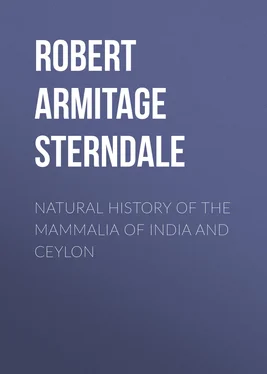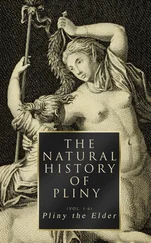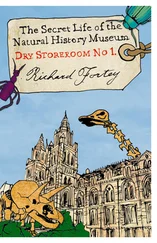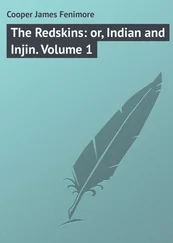Robert Armitage Sterndale - Natural History of the Mammalia of India and Ceylon
Здесь есть возможность читать онлайн «Robert Armitage Sterndale - Natural History of the Mammalia of India and Ceylon» — ознакомительный отрывок электронной книги совершенно бесплатно, а после прочтения отрывка купить полную версию. В некоторых случаях можно слушать аудио, скачать через торрент в формате fb2 и присутствует краткое содержание. Жанр: foreign_edu, Биология, на английском языке. Описание произведения, (предисловие) а так же отзывы посетителей доступны на портале библиотеки ЛибКат.
- Название:Natural History of the Mammalia of India and Ceylon
- Автор:
- Жанр:
- Год:неизвестен
- ISBN:нет данных
- Рейтинг книги:5 / 5. Голосов: 1
-
Избранное:Добавить в избранное
- Отзывы:
-
Ваша оценка:
- 100
- 1
- 2
- 3
- 4
- 5
Natural History of the Mammalia of India and Ceylon: краткое содержание, описание и аннотация
Предлагаем к чтению аннотацию, описание, краткое содержание или предисловие (зависит от того, что написал сам автор книги «Natural History of the Mammalia of India and Ceylon»). Если вы не нашли необходимую информацию о книге — напишите в комментариях, мы постараемся отыскать её.
Natural History of the Mammalia of India and Ceylon — читать онлайн ознакомительный отрывок
Ниже представлен текст книги, разбитый по страницам. Система сохранения места последней прочитанной страницы, позволяет с удобством читать онлайн бесплатно книгу «Natural History of the Mammalia of India and Ceylon», без необходимости каждый раз заново искать на чём Вы остановились. Поставьте закладку, и сможете в любой момент перейти на страницу, на которой закончили чтение.
Интервал:
Закладка:
Dental formula: Inc., 4/4; can., 1—1/1—1; premolars, 2—2/3—3; molars, 3—3/3—3.
NATIVE NAMES.— Badul , Bengali and Mahratti; Wurbagul , Hindi; Toggul bawali , Canarese; Sikurayi , Telegu.
HABITAT.—All through India, Ceylon, and Burmah.
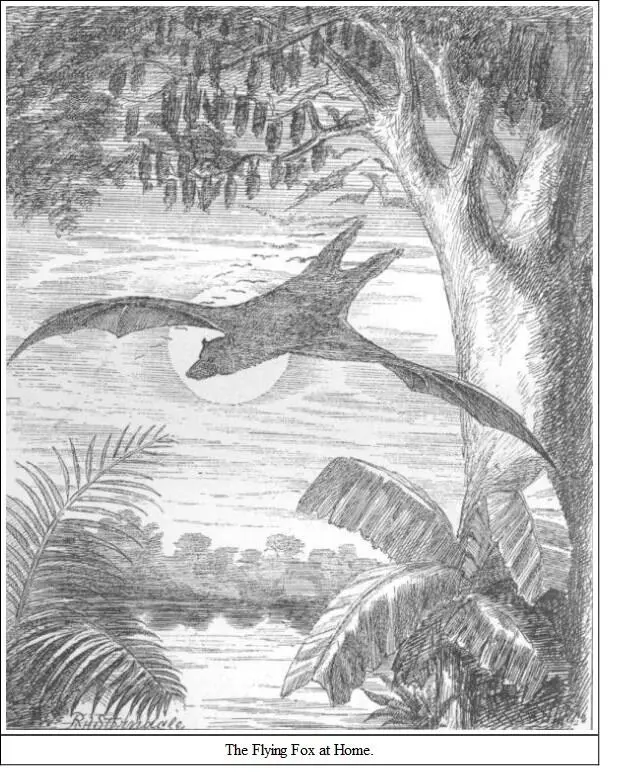
DESCRIPTION.—Head and nape rufous black; neck and shoulders golden yellow (the hair longer); back dark brown; chin dark; rest of body beneath fulvous or rusty brown; interfemoral membrane brownish black.— Jerdon .
SIZE.—Length, 12 to 14 inches; extent of wings, 46 to 52 inches.
These bats roost on trees in vast numbers. I have generally found them to prefer tamarinds of large size. Some idea of the extent of these colonies may be gathered from observations by McMaster, who attempted to calculate the number in a colony. He says: "In five minutes a friend and I counted upwards of six hundred as they passed over head, en route to their feeding grounds; supposing their nightly exodus to continue for twenty minutes, this would give upwards of two thousand in one roosting place, exclusive of those who took a different direction."

Tickell's account of these colonies is most graphic, though Emerson Tennent has also given a most interesting and correct account of their habits. The former writes:—"From the arrival of the first comer until the sun is high above the horizon, a scene of incessant wrangling and contention is enacted among them, as each endeavours to secure a higher and better place, or to eject a neighbour from too close vicinage. In these struggles the bats hook themselves along the branches, scrambling about hand over hand with some speed, biting each other severely, striking out with the long claw of the thumb, shrieking and cackling without intermission. Each new arrival is compelled to fly several times round the tree, being threatened from all points, and, when he eventually hooks on, he has to go through a series of combats, and be probably ejected two or three times before he makes good his tenure." For faithful portraying, no one could improve on this description. These bats are exceeding strong on the wing. I was aware that they went long distances in search of food, but I was not aware of the power they had for sustained flight till the year 1869, when, on my way to England on furlough, I discovered a large flying fox winging his way towards our vessel, which was at that time more than two hundred miles from land. Exhausted, it clung on to the fore-yard arm; and a present of a rupee induced a Lascar to go aloft and seize it, which he did after several attempts. The voracity with which it attacked some plantains showed that it had been for some time deprived of food, probably having been blown off shore by high winds. Hanging head-downwards from its cage, it stuffed the fruit into its cheeks, monkey-fashion, and then seemed to chew it at leisure. When I left the steamer at Suez it remained in the captain's possession, and seemed to be tame and reconciled to its imprisonment, tempered by a surfeit of plantains. In flying over water they frequently dip down to touch the surface. Jerdon was in doubt whether they did this to drink or not, but McMaster feels sure that they do this in order to drink, and that the habit is not peculiar to the Pteropodidæ , as he has noticed other bats doing the same. Colonel Sykes states that he "can personally testify that their flesh is delicate and without disagreeable flavour;" and another colonel of my acquaintance once regaled his friends on some flying fox cutlets, which were pronounced "not bad." Dr. Day accuses these bats of intemperate habits; drinking the toddy from the earthen pots on the cocoanut trees, and flying home intoxicated. The wild almond is a favourite fruit.
Mr. Rainey, who has been a careful observer of animals for years, states that in Bengal these bats prefer clumps of bamboos for a resting place, and feed much on the fruit of the betel-nut palm when ripe. Another naturalist, Mr. G. Vidal, writes that in Southern India the P. medius feeds chiefly on the green drupe or nut of the Alexandrian laurel ( Calophyllum inophyllum ), the kernels of which contain a strong-smelling green oil on which the bats fatten amazingly; and then they in turn yield, when boiled down, an oil which is recommended as an excellent stimulative application for the hair. I noticed in Seonee a curious superstition to the effect that a bone of this bat tied on to the ankle by a cord of black cowhair is a sovereign remedy, according to the natives, for rheumatism in the leg. Tickell states that these bats produce one at a time in March or April, and they continue a fixture on the mother till the end of May or beginning of June.
Dobson places this bat in the sub-group Cynonycteris . It seems to differ from Pteropus only, as far as I can see, in having a small distinct tail, though the above-quoted author considers it closely allied to the next genus.
HABITAT.—The Carnatic, Madras and Trichinopoly; stated also procurable at Calcutta and Pondicherry ( Jerdon ); Ceylon ( Kellaart ).
DESCRIPTION.—Fur short and downy; fulvous ashy, or dull light ashy brown colour, denser and paler beneath; the hairs whitish at the base; membranes dark brown.
SIZE.—Length, 5 to 5½ inches; extent of wing, 18 to 20 inches.
More information is required regarding the habits of this bat.
This genus has four molars less than the last, a shorter muzzle; the cheek-bones or zygomatic arch more projecting; tongue rather longer and more tapering, and slightly extensile.
Dental formula: Inc., 4/4 or 4/2; can., 1—1/1—1; premolars, 2—2/3—3; molars, 2—2/2—2.
NATIVE NAME.— Chamgadili , Hindi; Coteekan voulha , Singhalese.
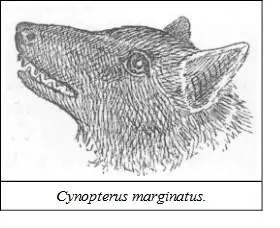
HABITAT.—India generally, and Ceylon.
DESCRIPTION.—General colour fulvous olivaceous, paler beneath and with an ashy tinge; ears with a narrow margin of white ( Jerdon .) A reddish smear on neck and shoulders of most specimens; membranes dusky brown. Females paler ( Kellaart ).
SIZE.—Length, 4½ to 5½ inches; extent of wing, 17 to 20 inches.
This bat is found all over India; it is frugivorous exclusively, though some of this sub-order are insectivorous. Blyth says he kept some for several weeks; they would take no notice of the buzz of an insect held to them, but are ravenous eaters of fruit, each devouring its own weight at a meal, voiding its food but little changed whilst slowly munching away; of guava it swallows the juice only. Blyth's prisoners were females, and after a time they attracted a male which hovered about them for some days, roosting near them in a dark staircase; he was also caught, with one of the females who had escaped and joined him. Dr. Dobson writes that in three hours one of these bats devoured twice its own weight. This species usually roosts in trees.
Читать дальшеИнтервал:
Закладка:
Похожие книги на «Natural History of the Mammalia of India and Ceylon»
Представляем Вашему вниманию похожие книги на «Natural History of the Mammalia of India and Ceylon» списком для выбора. Мы отобрали схожую по названию и смыслу литературу в надежде предоставить читателям больше вариантов отыскать новые, интересные, ещё непрочитанные произведения.
Обсуждение, отзывы о книге «Natural History of the Mammalia of India and Ceylon» и просто собственные мнения читателей. Оставьте ваши комментарии, напишите, что Вы думаете о произведении, его смысле или главных героях. Укажите что конкретно понравилось, а что нет, и почему Вы так считаете.
